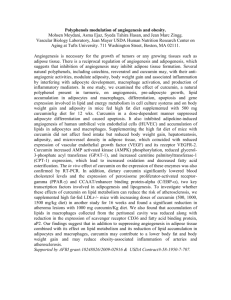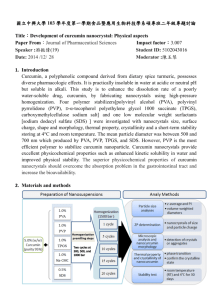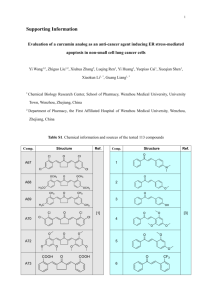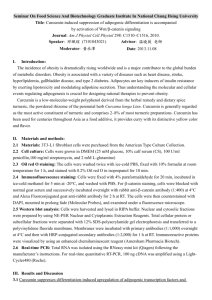1003030
advertisement
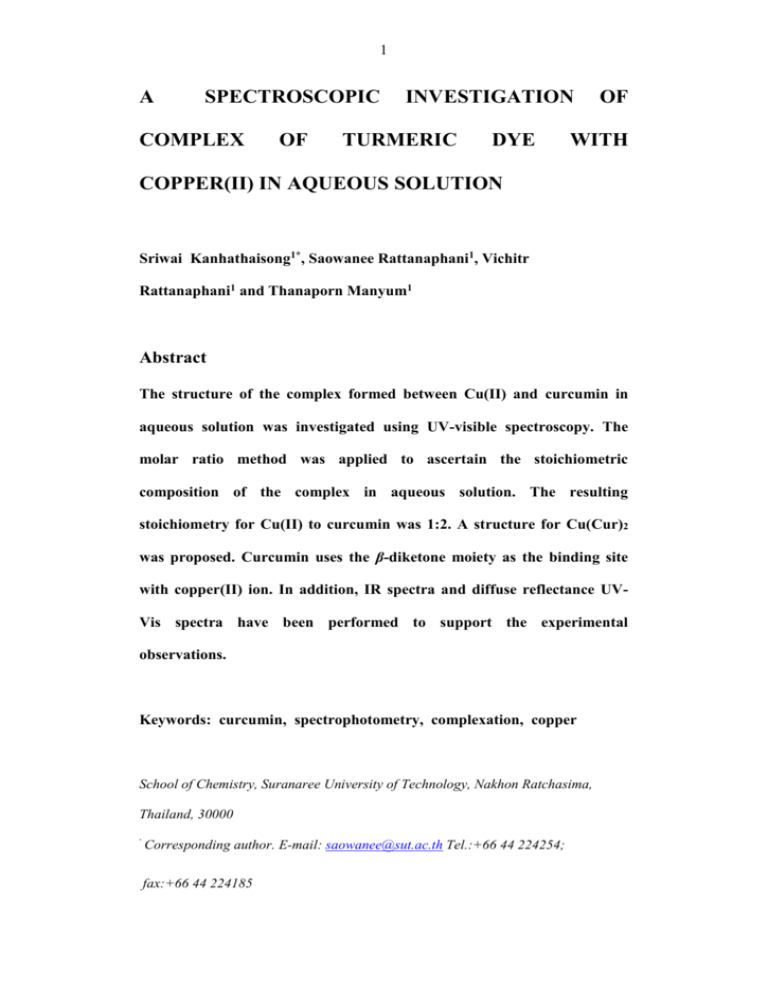
1 A SPECTROSCOPIC COMPLEX OF INVESTIGATION TURMERIC DYE OF WITH COPPER(II) IN AQUEOUS SOLUTION Sriwai Kanhathaisong1*, Saowanee Rattanaphani1, Vichitr Rattanaphani1 and Thanaporn Manyum1 Abstract The structure of the complex formed between Cu(II) and curcumin in aqueous solution was investigated using UV-visible spectroscopy. The molar ratio method was applied to ascertain the stoichiometric composition of the complex in aqueous solution. The resulting stoichiometry for Cu(II) to curcumin was 1:2. A structure for Cu(Cur)2 was proposed. Curcumin uses the β-diketone moiety as the binding site with copper(II) ion. In addition, IR spectra and diffuse reflectance UVVis spectra have been performed to support the experimental observations. Keywords: curcumin, spectrophotometry, complexation, copper School of Chemistry, Suranaree University of Technology, Nakhon Ratchasima, Thailand, 30000 * Corresponding author. E-mail: saowanee@sut.ac.th Tel.:+66 44 224254; fax:+66 44 224185 2 1. Introduction The rhizome of turmeric, Curcuma longa Linn., is an important source of a yellow natural pigment. The compounds responsible for the yellow pigment are curcumin[1,7-bis-(4-hydroxy-3-methoxyphenyl)-1,6-heptadien-3,5-dione] (Cur) and two curcuminoids, demethoxycurcumin (DC) and bisdemethoxycurcumin (BDC) (Jayaprakasha et al., 2005; Jayaprakasha et al., 2002; Jiang et al., 2006). Some studies on curcumin are based on the ionic structure where the keto-enol equilibrium (Figure 1) is present or when it is fully in keto form (Wang et al., 1997; Tonnesan, 1989; Tønnesen et al., 1982) with the resulting properties depending on the latter. The water solubility of curcumin is relatively low, although it is soluble in alcoholic media. The β-diketo moiety of curcumin undergoes keto– enol tautomerism. Crystal studies (Tønnesen, et al., 1982; Tønnesen, et al., 1983; Karlsen, et al., 1988) have shown that the symmetric structure of curcumin leads to a statistically even distribution of the enol proton between the two oxygen atoms. The strong chelating ability of diketones has been widely investigated towards a great number of metal ions. In such conditions the curcumin molecule should bind with species which have a positive or partially positive charge, for example, transition metal ion (Bates, 2000). Turmeric dyes have been used as a natural dye for centuries (Moeyes, 1993). Unfortunately, the use of natural yellow dyes are related to “poor fastness” due to its problematic issues in light fastness and wash fastness properties. Curcuminnoids have particular disadvantages when dyeing onto silk fibroin, cotton and wool (Popoola, 2000.; Tsatsarosi et al., 1998; 3 Yoshizumin, 2003). The solution is usually to use metal ions as mordants (Tsatsaroni et al., 1998). Metal complex formation has been a well-known feature of textile dyeing from very early times, since it was recognized that the technical performance, including fastness to washing and light, of many natural dyes could be enhanced by treatment with certain metal ions, a process known as mordanting (Christie, 2001). In the northeast of Thailand, villagers are usually use trial and error methods to find some mordants for silk dyeing (Moeyes, 1993). Alum and salt, iron oxide and copper sulphate are common examples. Copper(II) sulphate (CuSO4)∙5H2O) is widely used as mordant for dyeing silk fibre with polyphenolic dyes to obtain bright colours and improve fastness to light and wash (Christie, 2001). However, the complex formation of copper(II) with curcumin which is a major composition of curcuminoid dyes in aqueous solution has not yet been reported. The aim of this present work is to determine the stoichiometric composition of curcumin – Cu(II) complex formed between curcumin and Cu(II) ion in an aqueous solution. The complex formation between curcumin dyes and Cu(II) ion were investigated by using the UV-Vis spectrophotometry method. These complexes can be directly applied to dyeing silk. 2. Materials and Method All chemicals in this study, copper(II) nitrate trihydrate (Cu(NO3)2.3H2O), sodium hydroxide (NaOH), ammonium acetate, acetic acid and ethanol were 4 A.R. grade obtained from Merck, while 98% curcumin [458-37-7] was purchased from Across Organics. 2.1 Determination of the Mole Ratio for the Cu(II)-Curcumin Complex The molar ratio method was used to determine the composition of this complex in aqueous solution from spectrophotometric spectra. For this method, fresh 5.0×10-3 M curcumin stock solution was prepared by dissolving 0.1842 g of curcumin in 100 mL ethanol directly in the volumetric flask and it’s kept in reagents bottle. Copper(II) nitrate solution was prepared in deionized water. A concentration of 2.5×10-5 M of curcumin in aqueous solution was prepared by pipetted 50 μL of 5.0×10-3 M curcumin stock solution into 10 mL volumetric flask, and adjusted using deionized water. A concentration of 2.5×10-5 M of curcumin in aqueous solution was kept constant whereas the copper(II) nitrate stock solution was varied from 0 to 2.5×10-5 M. The pH was controlled using a buffer system consisting of 4% of 1.0 M ammonium acetate-acetic acid buffer (optimum pH 5.5) and was added to a mixture of copper(II) and curcumin dye. In order to reach the complexation equilibrium, the absorption spectra of the solution was recorded after standing for 20 minutes. An Agilent 8453 UV-Vis spectrophotometer was employed for measuring absorbance values using quartz cells of path length 1 cm. 2.2 Preparation of Cu(II)-Curcumin Solid Complex The synthesis of the solid 1:2 complexes between copper(II) ion and curcumin was carried out by the addition of 10 mL MeOH to 0.25 mmol curcumin, after which 240 mL deionized water was added, followed by the 5 drop-wise addition of copper(II) nitrate 0.125 mmol in aqueous solution, which was stirred for 2 hours at room temperature. After standing overnight, a yellow green solution, a gelatinous residual product appeared. This was then isolated by vacuum filtration, washed with cold MeOH and dried overnight in desiccator. The solid crude was then recrystalized in MeOH and acetic acid. The crystal was separated and washed with cold MeOH-water. Diffuse reflectance UV-Vis spectrophotometry was used to characterize the solid complex. IR spectrophotometry was used to observe the stretching frequency of the carbonyl group of β-diketone moiety in Cu(II)-curcumin complex. 3. Results and Discussion 3.1 UV-Visible Spectra of Curcumin in Aqueous Solution and at pH 5.5 From a molar ratio method, it was found that increasing the Cu(II) concentration decreases the absorption band at 427 nm and also results in the appearance of a new band at 361 nm. The effect of Cu(II) concentration on visible spectra (λmax) of curcumin with pH control at 5.5 is shown in Figure 2 and indicates a large hypsochromic shift of 66 nm in band 427 nm. The UV-Vis region showed two absorption bands of curcumin ligands: an n→π* transition at ~360-430 nm and π→π* transition at ~240-290 nm (Barik, et.al., 2007). The absorption band showed decay of parent Cu(II)curcumins band at 427 nm after being mixed with copper(II) ions. The UVVis spectrum of curcumin in aqueous solution at pH 5.5 exhibits a maximum adsorption band at 427 nm with an extinction coefficient of 28,268. A new 6 band which increases with the amount of added copper(II) appeared at 361 nm with an extinction coefficient of 17,244. The 427 nm peak due to curcumin in aqueous solution is attributed to the n→π* transition of curcumin. A 361 nm band (Figure 2) is attributed to the curcumin →Cu(II) charge transfer band (TØnnesen, et.al., 1992). This study corresponds to Barik, et.al. (2007) in which β–diketone of curcumin chelated with copper in DMSO and Zhao, et.al. (2005) shows a large blue shift of β– diketone of trans-ASTX with copper from 480 nm to 373 nm in ethanol. 3.2 Complex Stoichiometry of Curcumin and Copper(II) in Aqueous Solution at pH 5.5 In this study, the stoichiometry of the complex was determined by using the molar ratio method. Increasing the copper(II) ion resulted in a decrease of an absorbance at 427 nm (Figure 3), which showed inflection at [Cu]/[curcumin] = 0.45, indicates stoichiometric of Cu(II) to curcumin of 1:2 for the complex. The diffuse reflectance UV-Vis spectrum of solid crystal of Cu(II)curcumin (Figure 4) showed three major absorption bands with wavelength maxima at 316 nm (band I), 472 nm (band II), and 701 nm (band III), respectively. An intense band I with occurred in the UV region is considered to be associated with the absorption due to π→π* transition of curcumin, and band II at 400-550 nm was due to n→π* transition of curcumin ligand (Annaraj, et.al. 2004; Barik, et.al., 2007). A broad band III centered on the 700 nm is usually assigned to a d-d transition band (Welch and Champman, 7 1993), indicating that the solid was a compound of copper(II) with curcumin. Cu(II) was present in the complex and coordinated to curcumin ligand (Figure 5). IR spectra of curcumin copper(II) complex showed the υ (C=O) band at 1,627 cm-1 which is less intense than in the free curcumin. The υ (C-O-Cu) band of the complex at 467 cm-1 suggested that curcumin forms a complex with copper(II) and uses β-diketone part as the binding site (Barik et.al., 2007). Figure 5 showed the proposed structure of the Cu(Cur)2 complex in aqueous solution and in solid state. 4. Conclusions The interaction of curcumin and Cu(II) was studied by UV-Vis spectroscopy and the significant large hypsochromic shift observed for absorption band of Cu(II)-curcumin complex. Using the molar ratio method, it was found that the stoichiometric composition of the complex in aqueous solution was Cu(curcumin)2. The diffuse reflectance UV-Vis spectra and IR spectra indicated it was likely to be reasonably stable both in aqueous solution and in solid state. Acknowledgements We gratefully acknowledge support from Suranaree University of Technology, and Kumaung Wittaya School, Chaiyaphum, Thailand. 8 References Annaraj, J.P., Ponvel, K.M., and Athappan, P. (2004). Synthesis, spectra and redox behavior of copper(II) complexes of curcumin diketimines as models for blue copper proteins. Transit. Metal. Chem., 29(7):722– 727. Barik, A., Mishra B., Kunwar, A., Kadam, R.M., Shen, L., Dutta, S., Padhye, S., Satpati, A.K., Zhang, H.Y., and Priyadarsini, K.I. (2007). Comparative study of copper(II)-curcumin complexes as superoxide dismutase mimics and free radical scavenger. Eur. J. Med. Chem., 42(4):431-439. Bates, R. (2000). Organic Synthesis using Transition Metals. United States of America: Sheffield Academic Press, 190p. Bernabé-Prineda. M., Ramírez-Silva M.T., Romero-Romo, M., GonzálezVergara, E., and Rojas-Hernández, A. (2004). Determination of acidity constants of curcumin in aqueous solution and apparent rate constant of its decomposition. Spectrochimica. Acta. Part A, 60(5):1091-1097. Borsari, M., Ferrari, E., Grandi, R., and Saladini, M. (2002). Curcuminoids as potential new ion- chelating agents: spectroscopic, polarographic and potentiometric study on their Fe(II) complexing ability, Inorg. Chim. Acta, 328(1):61-68. Christie, R.M. (2001). Colour chemistry. Royal Society of Chemistry, United Kingdom, p. 12-134. Welch, A.J., and Champman, S.K. (1993). The chemistry of the copper and 9 zinc triads. Royal Society of Chemistry, United Kingdom, 259p. Jayaprakasha, G.K., Jagan Jagan, Mohan Rao, L., and Sakariah, K.K. (2002). Improved HPLC for the determination of curcumin, demethoxycurcumin, and bisdemethoxycurcumin. J. Agric. Food. Chem., 50(13): 3663-3672. Jayaprakasha, G.K., Jagan Mohan Rao, L., and Sakariah, K.K. (2005). Chemistry and biological activities of C.longa. Trends. Food. Sci. Tech., 16(12):533-548. Jiang, H., Timmermann, B.N., and Gang, D.R. (2006). Use of liquid chromatography-electrospray ionization tandem mass spectrometry to identify diaryheptanoids in turmeric (Curcuma longa L.) rhizome. J. Chromatogr. A, 1111(1):21-31. Karlsen J., Mostad A., and Tønnesen H.H. (1988). Structural studies of curcuminoids. VI. Crystal structure of 1,7 Bis(4-hydroxyphenyl)-1,6heptadiene-3,5-dione hydrate. Acta. Chem. Scand., 42:23-27. Moeyes, M. (1993). Natural dyeing in Thailand. Bangkok: White Lotus. Mohammadi, K., Thompson, K.H., Patrick, B.O., Storr, T., Martins, C., Polishchuk, E., Yuen, V.G., and McNeill, J.H. (2005). Synthesis and characterization of dual function vanadyl, gallium and indium curcumin complexes for medicinal applications, J. Inorg. Biochem., 99(11):22172225. Popoola, A.V. (2000). Comparative fastness assessment performance of cellulosic fibers dyed using natural colorants. J. Appl. Polym. Sci., 77(4):752-755. 10 Shen, L., Zhang, H., and Ji, H. (2005). A theoretical study on Cu(II)-chelating properties of curcumin and its implications for curcumin as a multipotent agent to combat Alzheimer’s desease. J. Mol. Struc-Theochem., 757(13):199-202. Tsatsaroni, E., Liakopoulou-Kyriakides, M., and Eleftheriadis, I. (1998). Comparative study of dyeing properties of two yellow natural pigmentseffects of enzymes and proteins. Dye Pigments, 37(4):307-315. Tønnesen H.H., Karlsen J., and Mostad A. (1982). Studies on Curcumin and Curcuminoids. XXXIX. Photophysical Properties of Bisdemethoxycurcumin. Acta Chem. Scand., 36:475-479. Tonnesan H.H. (1989). Studies on curcumin and curcuminoids XV. Catalytic effect of demethoxy and bisdemethoxy curcumin on the peroxidation of linoleic acid by 15-lipoxygenase. Int. J. Pharm., 51(4):179–181. Tønnesen H.H., Karlsen J., Mostad A., Pedersen U., Rasmussen P.B., and Lawesson S.O. (1983). Electro analytical study of the interaction between dsDNA and curcumin in the presence of copper(II). Acta. Chem. Scand., 37(4-5):179-185. Tønnesen, H.H. and Karlsen, J. (1992). Studies on curcumin and curcuminoids, XXII. Curcumin as reducing agent and as a radical scavenger, Int. J. Pharm., 87(1-3):79-87. Tønnesen, H.H., Másson, M., and Loftsson, T. (2002). Studies of curcumin and curcuminnoids. XXVII. Cyclodextrin complexation: solubility, chemical and photochemical stability. Int. J. Pharm., 244(1-3):127-135. Wang, Y.-J., Pan, M.-H., Cheng, A.-L., Lin, L.-I., Ho, Y.-S., Hsieh, C.-Y., and Lin, J.-K. (1997). Stability of curcumin in buffer solutions and 11 characterization of its degradation products. J. Pharm Biomed. Anal., 15(12):1867-1876. Yoshizumi, K., and Crews, P.C. (2003). Characteristic of fading of wool cloth dyed with selected natural dyestuffs on the basis of solar radiant energy. Dye. Pigments., 58(3):197-204. Zhao, L., Chen, F., Zhao, G., Wang, Z., Liao, X. and Hu, X. (2005). Isomerization of trans-Astaxanthin induced by copper(II) ion in ethanol, J. Agric. Food. Chem., 53(24):9620-9623. 12 OH R 1 3 '' 2 '' 2' 1 '' 1' 1 2 4 '' HO O 3 4 5 6 6 '' 3' R 2 7 6' 5 '' 5' Figure 1 4' OH R 1 3 '' 2 '' 3 5 2' 1' 1 2 6 '' 5 '' O 1 '' 4 '' HO O 4 6 3' R 2 7 6' 5' 4' OH 13 427 nm 0.8 0.7 Absorbance 0.6 361 nm 0.5 0.4 0.3 0.2 0.1 200 300 400 500 600 Wavelength (nm) Figure 2 700 800 14 Absorbance at 427 nm 0.60 0.55 0.50 0.45 0.40 0.35 0.1 0.2 0.3 0.4 0.5 0.6 0.7 0.8 0.9 1.0 2+ [Cu ] / [Cur] Figure 3 15 Absorbance 2.0 316 nm(band I) 1.5 472 nm(band II) 1.0 701 nm(band III) 0.5 0.0 200 300 400 500 600 700 800 900 1000 1100 Wavelength (nm) Figure 4 16 OCH OCH 3 HO 3 OH O H 2O OH2 O OH aqueous solution Figure 5 O Cu O 3 OCH 3 OH O HO OCH OCH 3 O Cu O OCH HO 3 O HO OH OCH OCH 3 solid state 3 17 Compounds R1 R2 Cur OCH3 OCH3 368 DC OCH3 H 338 BDC H 307 H MW Figure 1 The equilibrium of keto-enol formations of curcuminoid Figure 2 Electronic absorption spectra of curcumins (2.5×10-5 M) in aqueous solution in the absence and presence of copper(II) from 0 to 2.5×10-5 M at pH 5.5 Figure 3 Absorbance versus [Cu]/[curcumin] molar ratio plots at 427 nm at pH 5.5. Figure 4 The diffuse reflectance UV-Vis spectrum of solid crystal of Cu-curcumin complex Figure 5 The proposed structure of the Cu(curcumin)2 complexes.
